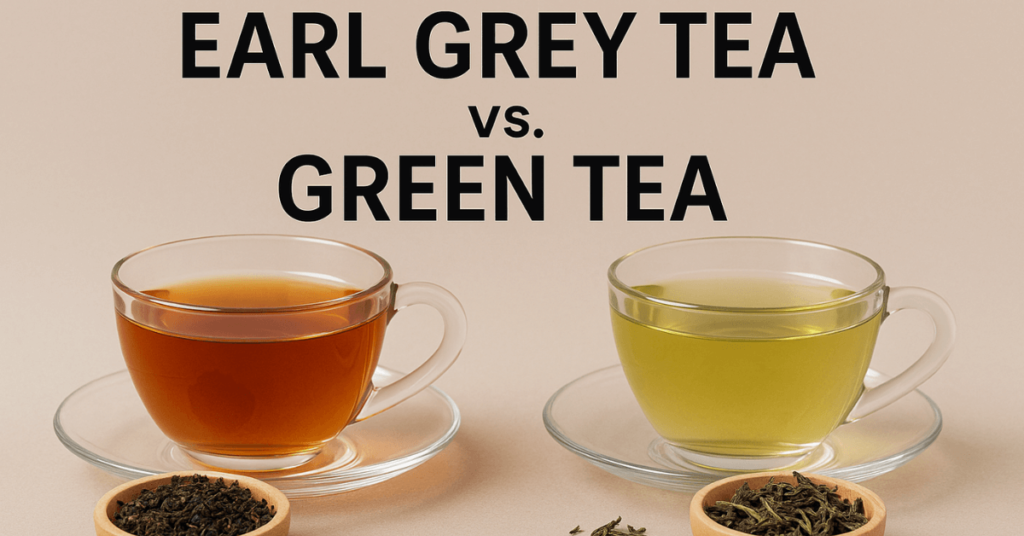Earl Grey Tea vs. Green Tea: Which is Better for Your Health?
Earl Grey Tea vs. Green Tea: Which is Better for Your Health?When it comes to choosing a healthy cup of tea, many people wonder about the differences between Earl Grey tea vs. green tea. Both are widely consumed, packed with antioxidants, and linked to numerous health benefits. But which one should you choose — Earl Grey or green tea? Let’s explore their unique qualities, benefits, and how they compare in terms of health and weight loss.

Earl Grey Tea vs. Green Tea
Earl Grey tea is a black tea infused with oil from the rind of bergamot orange, giving it a distinct citrus flavor. It’s aromatic, slightly bold, and contains moderate caffeine.
Green tea, on the other hand, is made from unoxidized leaves of the Camellia sinensis plant. It has a lighter, grassy taste and lower caffeine content compared to black tea.
Both teas are rich in antioxidants, but they differ in type:
- Earl Grey contains theaflavins from black tea and natural compounds from bergamot.
- Green tea is rich in catechins, particularly EGCG, which is linked to powerful health benefits.
Benefits of Earl Grey Tea vs. Green Tea
Benefits of Earl Grey Tea
- Supports digestion and may reduce bloating.
- Provides a moderate energy boost without jitters.
- Contains antioxidants that support heart health.
- Bergamot oil may help reduce stress and improve mood.
Benefits of Green Tea
- High in catechins that fight free radicals and reduce inflammation.
- Boosts brain function and may lower the risk of Alzheimer’s and Parkinson’s.
- Supports heart health by lowering cholesterol and improving blood circulation.
- Known for enhancing metabolism and fat burning.
Benefits of Earl Grey Tea vs. Green Tea for Weight Loss
If weight management is your goal, comparing Earl Grey tea vs. green tea for weight loss is important.
- Green Tea for Weight Loss: Green tea is widely recognized for boosting metabolism and increasing fat oxidation. Its catechins, particularly EGCG, play a direct role in supporting calorie burn and weight reduction.
- Earl Grey Tea for Weight Loss: While not as strong as green tea in fat burning, Earl Grey still offers benefits. The bergamot oil in Earl Grey may aid in fat metabolism and help balance cholesterol levels.
Verdict: For weight loss, green tea is usually more effective, but Earl Grey can still be a valuable addition to a healthy lifestyle.
Earl Grey vs. Green Tea: Health Perspective
When looking at Earl Grey vs. green tea for health, the differences are clear:
- Green tea is excellent for disease prevention due to its high antioxidant and catechin levels.
- Earl Grey tea supports digestion, reduces stress, and promotes heart health with the added benefits of bergamot.
Both are beneficial, but green tea has a slight edge for long-term wellness.
Earl Grey Black Tea vs. Green Tea
Since Earl Grey is a black tea, it naturally contains more caffeine than green tea. This makes it a great choice for those who want a stronger flavor and an energy boost.
Green tea is gentler on the system, making it suitable for people sensitive to caffeine or those who prefer a lighter, calming tea.
Is Earl Grey Tea or Green Tea Better?
So, is Earl Grey tea or green tea better? The answer depends on your needs:
- Choose green tea if you want to maximize antioxidants, aid weight loss, and support long-term disease prevention.
- Choose Earl Grey tea if you prefer a bold, citrus-flavored tea that promotes heart health, digestion, and relaxation.
Ultimately, both teas are excellent for health. You don’t have to pick one over the other — alternating between Earl Grey tea and green tea allows you to enjoy the unique benefits of each.
🌿 Green Tea Benefits
- Rich in antioxidants (catechins like EGCG): Helps protect cells from damage, supports heart health, and may reduce cancer risk.
- Weight management: Slight metabolism-boosting effect; may aid fat oxidation during exercise.
- Brain health: Contains L-theanine + caffeine, improving alertness, focus, and calmness without jitters.
- Heart health: Can help lower LDL (“bad”) cholesterol and improve blood vessel function.
- Blood sugar support: May improve insulin sensitivity and help regulate glucose levels.
- Dental health: Catechins reduce bacteria growth, improving oral hygiene.
- Calming effect: L-theanine promotes relaxation while keeping you alert.
🍊 Earl Grey Tea Benefits (Black tea + Bergamot oil)
- Heart health: Black tea polyphenols may help reduce blood pressure and LDL cholesterol.
- Digestive support: Bergamot oil has compounds that may soothe digestion and reduce gut inflammation.
- Stress relief & mood boost: The citrus aroma from bergamot can have calming, anti-anxiety effects.
- Energy & focus: Contains more caffeine than green tea, boosting alertness and productivity.
- Immune support: Bergamot oil has antimicrobial and antioxidant properties that may strengthen immunity.
- Oral health: Like green tea, black tea contains polyphenols that reduce plaque formation.
⚖️ Key Differences
| Feature | Earl Grey (Black Tea + Bergamot) | Green Tea |
|---|---|---|
| Caffeine | Higher (~40–70 mg per cup) | Lower (~20–45 mg per cup) |
| Antioxidants | Rich in theaflavins & thearubigins (good for heart & gut) | Rich in catechins like EGCG (stronger antioxidant power overall) |
| Unique Compound | Bergamot oil → mood lift, digestive aid | L-theanine → calm focus |
| Best For | Energy, mood boost, digestion | Weight management, brain health, blood sugar balance |
✅ Choose Green Tea if: you want stronger antioxidants, metabolism support, or a gentler caffeine boost.
✅ Choose Earl Grey if: you want more energy, love citrus flavor, or want mood + digestive benefits.
Frequently Asked Questions (FAQs)
1. Can I drink Earl Grey tea and green tea daily?
Yes, both teas can be enjoyed daily in moderation. Green tea is often consumed 2–3 times a day, while Earl Grey is best limited to 1–2 cups due to its caffeine content.
2. Which has more caffeine: Earl Grey tea or green tea?
Earl Grey tea, being a black tea, typically contains more caffeine than green tea. If you’re caffeine-sensitive, green tea is the better choice.
3. Is Earl Grey tea healthier than green tea?
Not necessarily. Green tea is higher in catechins and antioxidants, making it slightly stronger for disease prevention. Earl Grey offers unique benefits from bergamot oil, which supports digestion and heart health.
4. Which tea is better for weight loss: Earl Grey or green tea?
Green tea is more effective for weight loss due to its catechins that boost metabolism and fat burning. However, Earl Grey can still support healthy weight management.
5. Can I drink both Earl Grey and green tea in one day?
Absolutely! Many tea drinkers enjoy green tea in the morning for its metabolism-boosting properties and Earl Grey in the afternoon for a flavorful pick-me-up.


This comparison between the two teas is quite enlightening! The emphasis on antioxidants caught my attention, as it highlights their health benefits. I do agree that green tea seems to have a slight advantage for long-term wellness, but I wonder if the difference is significant enough to completely switch preferences. Have you personally noticed any long-term health improvements from consuming green tea regularly? I’m curious if brewing methods or specific brands make a difference in maximizing these benefits. What’s your take on incorporating both teas into a daily routine?
By the way, I’ve integrated libersave into our regional voucher system. It’s amazing how effortlessly it combines various providers on a single platform! Whith regards, EURFP
Thank you for your comment.